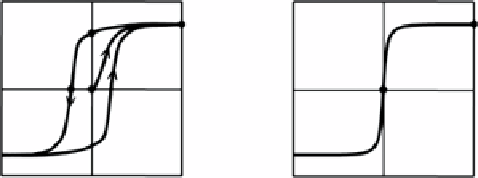Biomedical Engineering Reference
In-Depth Information
(a)
M
s
M
s
M
r
H
c
M
M
H
H
(b)
z
z
z
z
M
z
RF on
RF off
M
xy
y
y
y
y
x
x
x
x
fIgure 2.2
Schematic illustrations of (a) the hysteresis loops of a group of ferromag-
netic (left) and superparamagnetic NPs (right). (b) Schematic illustration of spin orienta-
tion of the proton under a permanent magnetic field (in
z
-direction) and a resonant
RF perturbation field that is perpendicular to the permanent field direction. The RF field
perturbs the magnetization of spins into
xy
-directions. Subsequent removal of this RF irra-
diation causes spin to realign along the
z
-direction—a process called spin relaxation. The
process leading to moment increase in
z
-direction is called
T
1
relaxation, while that leading
to moment decrease in
xy
-directions is called
T
2
relaxation. (Reproduced with permission
from Ref. [6]. © Wiley.)
(
M
r
) after the removal of the external field. To fully demagnetize these MNPs requires
an external field in the opposite direction and in certain strength, called coercive field
or coercivity (
H
c
) [11, 14]. When the size of a single-domain MNP decreases to a
certain degree, superparamagnetism occurs and the remnant
M
r
drops to zero in the
absence of the external magnetic field. Figure 2.2a displays the representative hyster-
esis loops of a group of ferromagnetic NPs and superparamagnetic NPs. The super-
paramagnetism originates from the thermal-induced magnetization reversal and is
defined by
e
KV kT
/
2
ττ
=
(2.1)
u
0
in which
τ
is the magnetization relaxation time,
K
u
is the particle's magnetic anisotropy
constant,
V
is the particle volume,
k
is Boltzmann's constant, and
T
is temperature
[3, 15]. In the critical size where the thermal energy (
kT
) is comparable to magnetiza-
tion reversal energy (
K
u
V
), the single-domain MNPs can be demagnetized by thermal
fluctuation without the external field reaching the superparamagnetic state. The super-
paramagnetic NPs have negligible magnetic dipole interactions and therefore can be
dispersed and stabilized in the liquid media for biological applications [3].


Search WWH ::

Custom Search